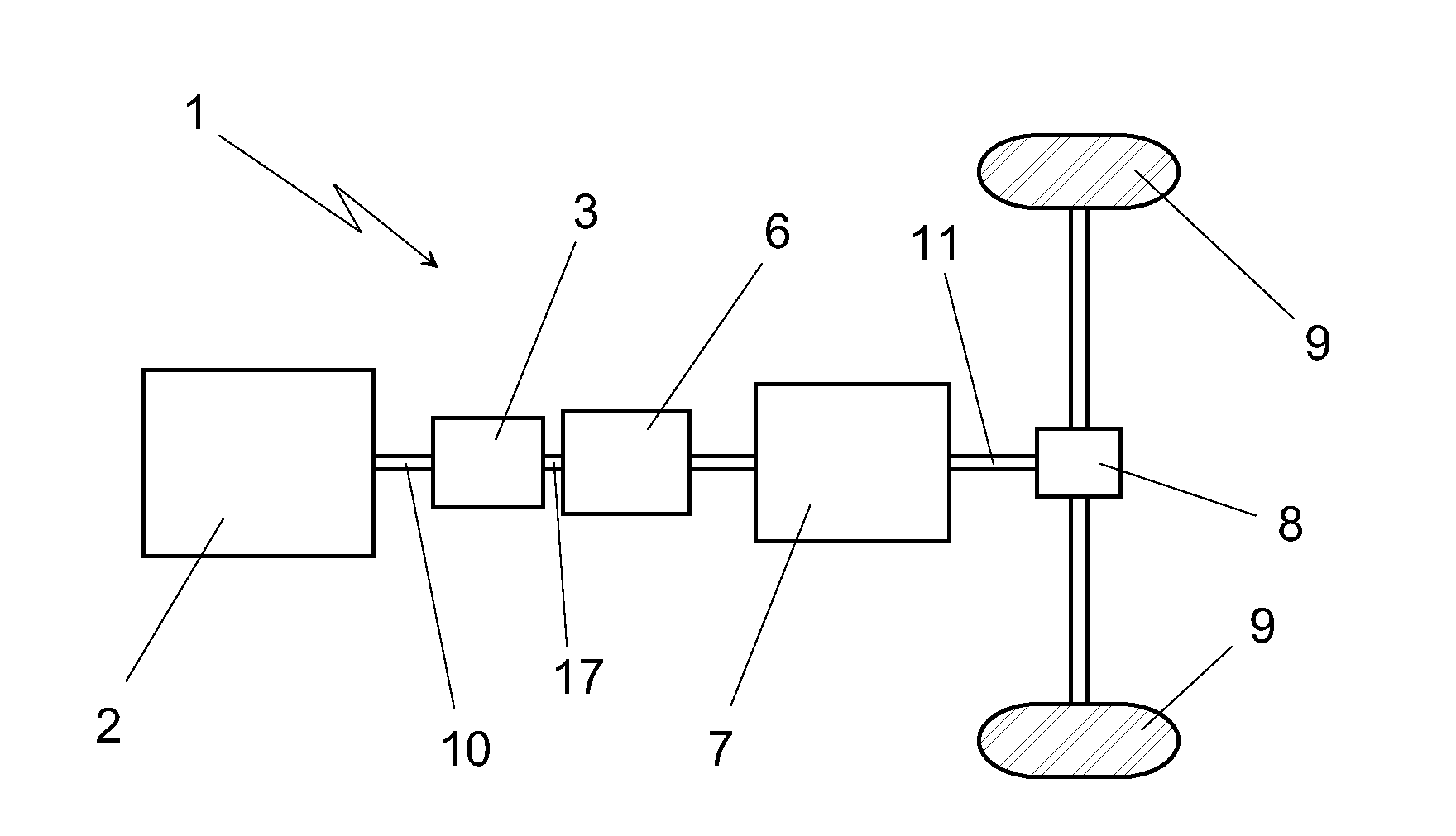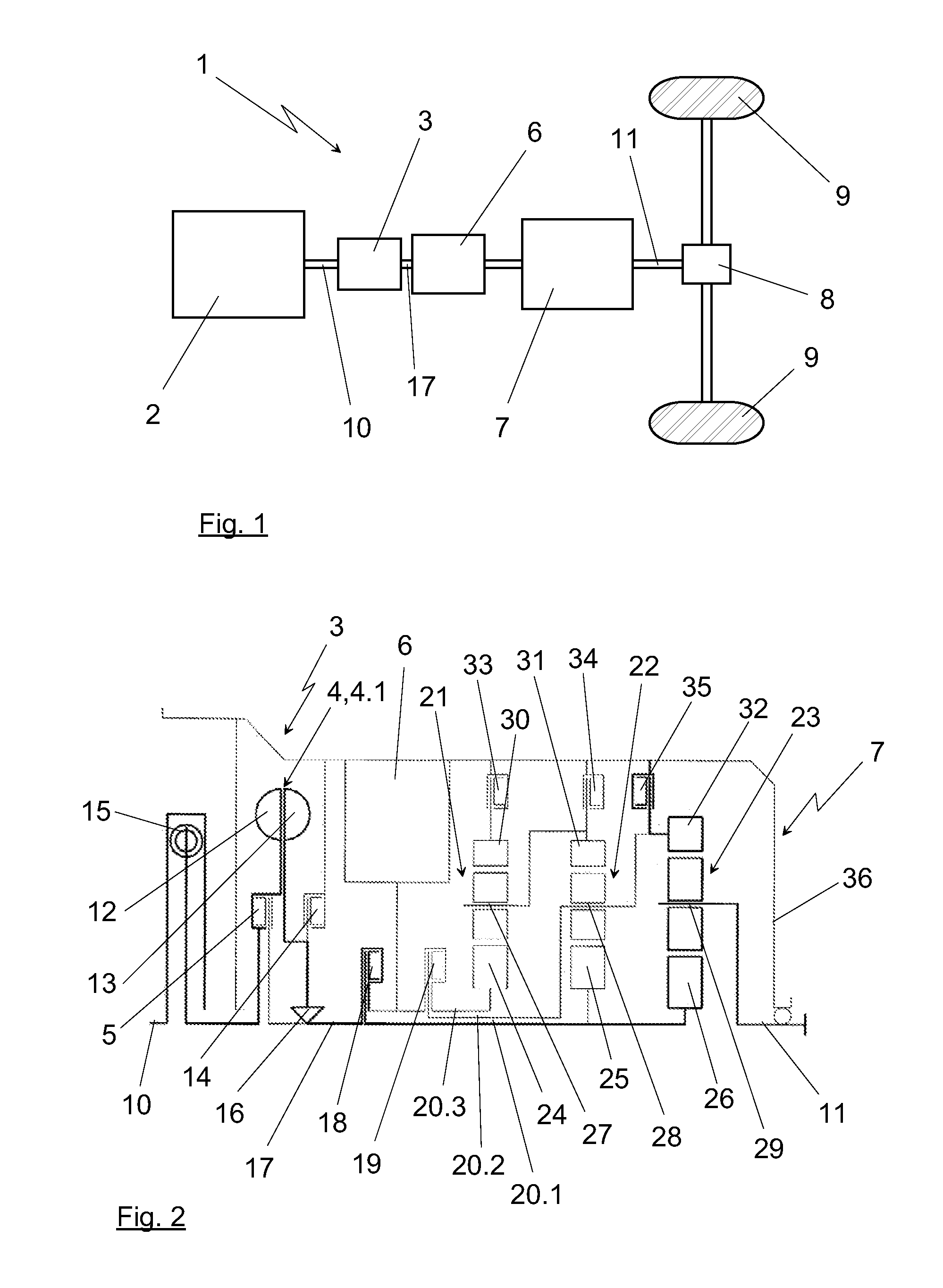Drive train for a motor vehicle
a technology for driving trains and motor vehicles, applied in the direction of engine starters, vehicle sub-unit features, gearing, etc., can solve the problems of electrical machines not being able to co-drive hydrodynamic components, electrical machines needing to cover a very large torque range, etc., to achieve the energy-saving and ecological advantage of hybrid drive, high mass of utility vehicles, and high energy-saving
- Summary
- Abstract
- Description
- Claims
- Application Information
AI Technical Summary
Benefits of technology
Problems solved by technology
Method used
Image
Examples
first embodiment
[0046]The illustrations of FIGS. 2 to 8 show an exemplary configuration of a section of such a drive train 1, with merely the portion of the rotationally symmetrical configuration disposed above the rotational axis being illustrated. FIGS. 2 to 8 show different shifting states of the configuration, which will be explained below and will explain the functionality of the configuration thereby.
[0047]The illustration of FIG. 2 shows the starting element 3, the powershift transmission 7 and the interposed electrical machine 6. An input shaft 10 into the starting element 3 is shown in the illustration as chosen in FIG. 2 on the left. It is simultaneously the output shaft of the primary drive unit 2, or it is connected directly or indirectly with the same. The configuration as shown in FIG. 2 ends on the right side with output shaft 11 of the powershift transmission 7, which drives the drive wheels 9 directly or—as indicated in the illustration of FIG. 1—via a transfer gear 8. A hydrodynam...
second embodiment
[0057]The illustration of FIG. 9 shows the drive train 1 in a manner comparable with FIGS. 2 to 8. Since the different gear steps and driving states can be realized similar to those described in FIGS. 2 to 8, FIGS. 9 to 18 merely show the structures of the configurations of the various possible embodiments of the drive train 1 without the thickness of the lines symbolizing the power flow, as was the case in FIGS. 2 to 8.
[0058]In the configuration as shown in FIG. 9, the hydraulic element 4 is also arranged as a hydrodynamic coupling, which is arranged with a rotating housing and is provided as a hydrodynamic coupling 4.2 with constant filling. The hydrodynamic coupling 4.2 with constant filling shall be understood with respect to its functionality in such a way that it is always filled at a constant degree of filling. Since the lock-up clutch 5 is closed in non-operation of the hydrodynamic coupling 4.2 and the components therefore revolve with the same rotational speed, the continu...
eighth embodiment
[0066]The illustration in FIG. 16 describes the same configuration as in the eighth embodiment in the illustration of FIG. 15, with the housing of the hydrodynamic torque converter 4.4 being connected in a torque-proof manner with the housing 36 in this case and the freewheel 42 can therefore be omitted. The guide wheel 41 is also connected in this case in a torsion-proof way with the housing 36. The turbine or secondary side 13 is coupled via the freewheel 16 with the powershift transmission 7 in a manner that has already been described several times above. As a result of the housing of the hydrodynamic converter 4.4 which is connected in a torsion-proof manner with the housing 36, filling of the hydrodynamic converter 4.4 with working medium will only occur in the first gear and in the reverse gear, similar to the hydrodynamic coupling 4.2 with constant filling, in order to minimize the occurring ventilation losses in the area of the hydrodynamic converter 4.4 in the other gears. ...
PUM
 Login to View More
Login to View More Abstract
Description
Claims
Application Information
 Login to View More
Login to View More - R&D
- Intellectual Property
- Life Sciences
- Materials
- Tech Scout
- Unparalleled Data Quality
- Higher Quality Content
- 60% Fewer Hallucinations
Browse by: Latest US Patents, China's latest patents, Technical Efficacy Thesaurus, Application Domain, Technology Topic, Popular Technical Reports.
© 2025 PatSnap. All rights reserved.Legal|Privacy policy|Modern Slavery Act Transparency Statement|Sitemap|About US| Contact US: help@patsnap.com



